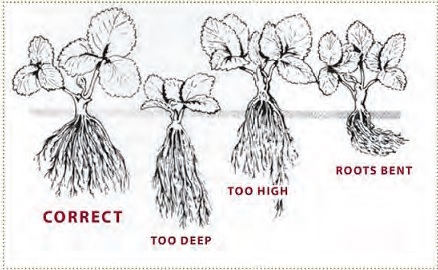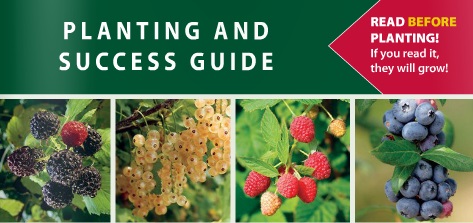How to Grow Strawberries
PLANTING
Strawberry leaves, roots, runners, and fruit all develop from the crown. Plant as soon as possible in the spring, after the soil has reached 50°F. Planting at the correct depth is very important. Dig a hole deeply enough that you are able to lower the plant into the ground without bending the roots. Set plants in the ground with the roots straight down. Make certain the plants are set, with the middle of the crown level with the top of the soil. We advise you not to cut any of the roots off your plants. Planting with Nourse Farms’ Strawberry Planting Tool ensures good soil contact and that the roots are straight.
Take care that the soil is pressed firmly, but not hard-packed around the plant roots. Be sure not to cover the crown. Check the soil level within a week or so, as the soil will likely settle, leaving roots exposed.
Avoid covering crowns with soil while you hoe, weed, and cultivate throughout the season.

IRRIGATION
Water thoroughly after planting and maintain good moisture throughout the season. Strawberries do best when they get one to two inches of rain or equivalent irrigation each week, depending on soil type. If irrigation is not available, select a site with good water-holding capacity, but avoid wet soils. Strawberries do poorly under drought conditions.
FERTILIZATION/SOIL PREPARATION
Avoid fertilizer burn. Applying fertilizer near the planting date leads to the burning of plant leaves and roots. Being too generous with fertilizer will also be detrimental. You may mix ½ lb. of 10-10-10 per 100 square feet into the soil, at least two to three weeks prior to planting. Otherwise, do not fertilize until your plants are established (about six weeks after planting). Fertilize June-Bearing varieties with ½ lb. 10-10-10 per 100 square feet again in July and in August. Day-neutral varieties should be fertilized weekly or bi-weekly once established to maintain growth and fruit production.
PREPARING FOR WINTER
Mulching is necessary in most northern states for winter protection of the crowns. Quick freezing and thawing can cause serious crown damage which may not only affect yield but also plant survival. An adequate layer of mulch mitigates fluctuating temperatures. Apply approximately four inches of straw or salt marsh hay after plants have started to go dormant or after six to ten hard frosts. Remove mulch in early spring before new growth starts. You can move the mulch to the aisles to keep weeds at bay and keep mud from splashing onto the fruit. You must cover the plants with straw again if cold temperatures are forecasted. A frost blanket or row cover can provide some degree of protection in the spring also. They must be removed by the time plants begin to bloom.
JUNE-BEARING STRAWBERRIES (Such as Jewel or Honeoye)
ESTABLISHING YEAR
Pinch off all the flower buds in the first year of growth. This allows plants to put energy into becoming established and in turn, yield a larger crop the first bearing year. It will also encourage runner production and support winter survival. You may let your rows fill in by allowing two to four daughters (runners) to take root on each side of the mother plant. Evenly space the plantlets in the bed five to eight inches apart, lightly pressing them into the soil to make sure there is good soil contact around the roots. Cut off any additional runners that form during the season. Over-crowded beds will produce small berries and can cause more disease problems.
SUCCEEDING YEARS AND RENOVATION
A process called ‘renovation’ is performed on June-bearing strawberry beds IMMEDIATELY AFTER HARVEST. This helps to keep plants healthy and productive over the years.
- Do not renovate in the establishment year.
- As soon as all the berries have been harvested, mow off the leaves or clip them to about three inches tall. Use your lawn mower set at the highest setting and collect the clippings in the mower bag or rake them off to help reduce disease. Take care not to cut or injure the crowns!
- Reduce crowding in the bed. Rototill the edges of the bed to narrow the bed width to 12–18 inches.
- Do not let additional daughter plants root.
- We recommend an application of 1 lb.-1 ½ lbs. of 10-10-10 per 100 sq. ft. at renovation. For the most efficient use of fertilizer, apply about 2/3 that rate at renovation and 1/3 in September.
- Complete the renovation process with good watering to get new growth off to a good start. Continue to maintain adequate moisture throughout the remainder of the growing season.
EVERBEARING/DAY-NEUTRAL STRAWBERRIES (Such as Evie-2 and Seascape)
PLANTING YEAR
- Day-neutral varieties can be planted in a single row with 12 inches between plants.
- We suggest ½ lb.-1 lb. of 10-10-10 fertilizer per 100 sq. ft. be worked into your soil at least two to three weeks before planting.
- Pinch off the first flush of flowers 3-4 weeks after setting out your plants. You can let plants develop fruit from midsummer through October.
- Four weeks after planting, side-dress with 1–1 ½ lbs. of 10-10-10 fertilizer per 100 sq. ft. After 8 weeks, begin weekly or bi-weekly application of a soluble fertilizer to maintain growth and fruit production.
- We recommend that you remove all the runners during the lifetime of the planting. This will allow the plants to become well-established.
- Hot weather will impact strawberry production. With day neutrals, the impact can be tempered with good watering practices. The cooler temperatures of autumn will bring a return of berry size and yield.
SUCCEEDING YEARS
DO NOT RENOVATE DAY-NEUTRAL OR EVERBEARING STRAWBERRIES.
- Commercial day-neutral plantings are typically grown as an annual, but plants can be overwintered for a second harvest season, though berry size can decrease.
- After new growth starts, begin weekly or biweekly application of soluble fertilizer, same as during the planting year.



